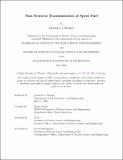Non-Neutron Transmutation of Spent Fuel
Author(s)
Wickert, Charlotte I.
DownloadThesis PDF (4.462Mb)
Advisor
Forget, Benoit
Terms of use
Metadata
Show full item recordAbstract
This thesis is a scoping study to assess the feasibility of utilizing non-neutron transmutation to target Long-Lived Fission Products (LLFPs), which account for 99% of the long-term radiotoxicity of spent nuclear fuel. With half-lives ranging from 100,000 to 10,000,000 years, LLFPs pose a significant obstacle to long-term high-level waste storage. Geologic repositories for nuclear waste must be functional for millions of years. This significant timescale contributes to the many technical and political challenges preventing the U.S. from closing the back end of the nuclear fuel cycle for High-Level Waste (HLW). The need for a geologictime-scale repository could be reduced if the most active isotopes present in HLW could be identified and transmuted. While disposal would still be necessary, a smaller time scale could resolve some of the most significant concerns associated with the current million-year time scale. Several computational methods, TALYS, TASMAN, PHITS, and FISPACT, are utilized to model the complete transport and transmutation process for proton irradiation to explore the potential of converting LLFP isotopes into stable or shorter-lived forms. TALYS is used to generate proton cross-sections for key LLFPs, as there are no differential cross section measurements in the energy range of interest (18-70 MeV). The uncertainty in the transmutation rate is calculated from the perturbed cross sections generated by TASMAN and TALYS in work supporting this thesis. The physics of the proton beam is modeled in supporting work using PHITS to provide a flux-energy spectrum and estimate the number of irradiated particles. Finally, FISPACT calculates the amount of depletion for each LLFP. A comparison of alpha and deuteron irradiation is performed using cross sections from the TENDL2021 library and SRIM to determine the penetration depth for each incident particle. Preliminary findings indicate that longer irradiation times and higher beam energies enhance transmutation, resulting in a decreased long-term abundance of LLFPs compared to natural decay conditions. For commercial proton accelerators with a 10mA current operating continuously, the transmutation rates for LLFPs range from 0.59 +- 0.12 g/year to 7.51 +- 1.19 g/year. Most LLFPs are produced in a 1 GW (thermal) reactor on the order of 1kg/year. Therefore, the transmutation rates achievable with commercial accelerators are too low to make a significant impact. However, increasing the proton beam energy to take advantage of proton spallation reactions may be successful, especially in the case of Selenium79. 660g/year of Selenium-79 are produced in a 1 GW (thermal) reactor. Initial spallation estimates show that for Selenium-79, approximately 24 g/year could be transmuted with a single accelerator. Future work will focus on improving the spallation irradiation scheme and target design. This work was supported by the DOE ARPA-E Project.
Date issued
2024-05Department
Massachusetts Institute of Technology. Department of Nuclear Science and EngineeringPublisher
Massachusetts Institute of Technology